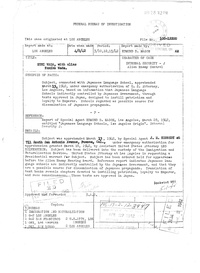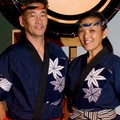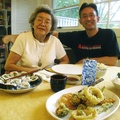Read part 1 >>
REVISITING THE PAST
It took a visit to a cemetery in his father’s hometown in Hawaii—where he learned that his middle name commemorated a childhood friend who had been killed in combat during the war—and the dedication of the National Japanese American Memorial in D.C. in 2000 to pique Paul’s curiosity and begin his engagement with his family’s history. 700 minutes of oral history interviews later, his book Nisei Memories: My Parents Talk about the War Years was published by the University of Washington Press in 2006.
Letting Ken and Alice Takemoto speak for themselves, the book eloquently chronicles how two young people weathered the disruptions and violence of the war. The interviews and letters of Alice and her sisters describe, for instance, the support they received from friends, their concern for their parents, the trauma of giving up the family dog, and the threatening phone calls they received the night before they were bused to Santa Anita. Ken’s accounts of his experiences reveal the terror and confusion of the battlefield. Wounded twice in action and discharged after the second time, he describes his efforts to visit the families of all the friends who had been killed in action, a poignant reflection of the deep sorrow and desperation that haunted many of these young soldiers.
Three years before Paul’s book was published, he and Alice attended the “Life Interrupted: The Japanese American Experience in World War II Arkansas” conference organized by the Japanese American National Museum and the University of Arkansas. They were skeptical about the event, and reluctantly registered after much persuasion by Alice’s sisters. But from the moment they arrived at the conference, they were swept up by the energy of the 1,200+ participants, the attention of local teachers and students, and the way in which revisiting the past can stir long-quiet emotions and revelation.
Paul still recalls with awe the impact of the student presentations on his mother, “who always assumed no one knew or cared about what happened back then.” He appreciated how a local resident led them to the location of their family barracks and the discussions he overheard among former inmates as they recalled their experiences. On a more amusing (though no less touching) note, he also remembers that while visiting one of the historical exhibitions at the conference, his mother was approached by a group of students, who wanted to ask her questions. Afterwards, they expressed their gratitude by breaking into an impromptu performance of Gloria Gaynor’s 1970s disco hit “I Will Survive.”
RECONNECTION
In spite of their World War II experiences and though far from their extended families, Alice and Ken Takemoto built a happy and full life for themselves and their two children in Maryland. Ken retired in 1984 after a distinguished career in virology at the National Institute of Health. Alice is a well respected pianist, both a performer and teacher, who continues to be active in D.C. area classical music activities. But as Alice told her son Paul, when he interviewed her in the early 2000s, “That was the thing about camp—you left and lost touch with people. You had no idea where they went.”
Over the years, she herself would occasionally hear from people who were trying to reconnect with her. And she remembers that her mother never stopped wondering aloud about the fate of an old friend, Mrs. Kuni Wada. Kuni was the wife of Reverend Masahiko Wada, the pastor of the Garden Grove Baptist Church that Alice’s family had attended. After Pearl Harbor was attacked, both Alice’s parents and the Wadas were arrested. Alice’s mother was in prison with Kuni Wada. But while she was eventually released, Kuni was sent to the federal prison for women in Seagoville,Texas. The families had been very close, but Alice’s mother never found out what had happened to Kuni Wada. Somehow in the movements between detention centers, the closing of the camps, and the strenuous effort to rebuild lives after the war, they had lost track of one another.
In 2008, Paul, his daughter, Alice, and her sisters attended JANM’s “Whose America? Who’s American? Diversity, Civil Liberties, and Social Justice” conference in Denver, Colorado. Alice and her sisters attended a session on “Nikkei Incarceration: World War II Assembly Centers, Relocation, Isolation, Segregation, and Internment Camps.” They sat up in the front row. Alice remembers, “I didn’t get the answers I was looking for, so afterwards I stood up. I NEVER would get up in a session like that, but somehow, I felt I had to ask. I stood up and said, ‘My mother was arrested—she was one of the 33 women—and she always wondered about this woman, Mrs. Wada, who was sent to Seagoville.’ And this voice from the back of the room said, ‘I’m her great-grandson.’ ”
Sitting three rows behind Alice and her sisters was Mitch Homma and his family. Mitch, a Sansei who lives in San Diego, had undertook a parallel effort to piece together and preserve his family’s immigration and World War II experiences, gathering and documenting information on volumes of documents and photographs. He recalls, “…. this woman gets up during the question and answer session and asks about the Reverend Wada family—especially Mrs. Wada. She didn’t understand why she was not released from Terminal Island like her mother…. I was sitting with my family, and we looked at each other and were like, ‘Who is this person?’ We were stunned. I told her that Kuni Wada was my great-grandmother. The whole room erupted with a cheer and round of applause.”
Since this meeting, Mitch Homma and the Takemotos have stayed in touch. They discovered in their family albums the same photograph—Alice sitting at a piano at the Wada’s home. Mitch Homma states, “I have a lot of respect and reverence for the Takemoto family. They really supported the Garden Grove Baptist Church and helped out my grandmother when she first came to the U.S. Meeting them in Denver was an honor. After 66 years, the families reconnected. My grandmother and her two younger brothers had already passed away. But the families still have that special bond that stands the test of time.”
And Paul explains, “My mother feels an enormous debt to Mitch and his family. His grandmother’s brother, Michihiko Wada, used to drive my mom and her sisters to see their mother when she was detained on Terminal Island—that is quite a distance. Their meeting in Denver is an example of the many ways the museum has allowed my family to reach a deeper understanding of our past.”
Since the conference, Paul has brought his mother out to Los Angeles to visit the Japanese American National Museum. The haiku presented at the top of this article reflects on that visit. It expresses the joy of bridging the distances and the disjunctures created by the incarceration and resettlement experiences—of finding resolution, homecoming, optimism, and new curiosity by engaging and recovering history.
© 2011 Japanese American National Museum








